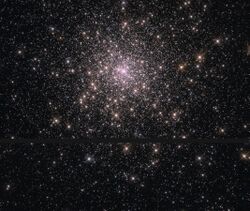Astronomy:NGC 6284
| NGC 6284 | |
|---|---|
 NGC 6284 as seen through the Hubble Space Telescope | |
| Observation data (J2000 epoch) | |
| Class | IX |
| Constellation | Ophiuchus |
| Right ascension | 17h 04m 28.747s[1] |
| Declination | −24° 45′ 51.22″[1] |
| Distance | 43,000 ly[2] (13,200 pc[2]) |
| Apparent magnitude (V) | 7.43[1] |
| Apparent dimensions (V) | 6.2' × 6.2'[3] |
| Physical characteristics | |
| Metallicity | [math]\displaystyle{ \begin{smallmatrix}\left[\ce{Fe}/\ce{H}\right]\end{smallmatrix} }[/math] = -1.26[4] dex |
| Estimated age | 13.3~ billion years |
| Other designations | GCl 53, 2MASX J17042874-2445512[1] |
NGC 6284 is a globular cluster located in the constellation Ophiuchus. It is designated as IX in the galaxy morphological classification scheme and was discovered by the German-born British astronomer William Herschel on 22 May 1784. Its distance had previously been estimated at 49,900 light years from Earth,[5][3][6][7][8] but this was revised in 2023 to around 43,000 light years.[2] This same study, based on high-resolution Hubble Space Telescope optical observations, produced the first high-quality colour-magnitude diagram (CMD) of NGC 6284, extending down to about six magnitudes below its main sequence turn-off. The new observations moved its centre of gravity by 1.5–3 arcseconds from previous values, and its density profile showed a steep central cusp, suggesting that NGC 6284 is a post-core collapse (PCC) cluster.
The nearby metal-poor star HD 194598 (es) may be a recent runaway from NGC 6284.[9]
See also
References
- ↑ 1.0 1.1 1.2 1.3 "NGC 6284". SIMBAD. Centre de données astronomiques de Strasbourg. http://simbad.u-strasbg.fr/simbad/sim-basic?Ident=NGC+6284.
- ↑ 2.0 2.1 2.2 "Globular cluster NGC 6284 inspected by astronomers". https://phys.org/news/2023-11-globular-cluster-ngc-astronomers.html.
- ↑ 3.0 3.1 "Revised NGC Data for NGC 6284". http://spider.seds.org/ngc/revngcic.cgi?NGC6284.
- ↑ "Catalog of Parameters for Milky Way Globular Clusters". http://physwww.mcmaster.ca/~harris/mwgc.dat.
- ↑ "Object No. 1 - NGC 6284". NASA/IPAC. http://ned.ipac.caltech.edu/cgi-bin/objsearch?objname=NGC+6284&extend=no&hconst=73&omegam=0.27&omegav=0.73&corr_z=1&out_csys=Equatorial&out_equinox=J2000.0&obj_sort=RA+or+Longitude&of=pre_text&zv_breaker=30000.0&list_limit=5&img_stamp=YES.
- ↑ "NGC 6284 (= GCL 53)". http://cseligman.com/text/atlas/ngc62a.htm#6284.
- ↑ "NGC 6284". http://spider.seds.org/spider/MWGC/n6284.html.
- ↑ "The globular cluster NGC 6284". https://in-the-sky.org/data/object.php?id=5051.
- ↑ Şahin, Timur; Bilir, Selçuk (2020), "On the Origin of Metal-poor Stars in the Solar Neighborhood", The Astrophysical Journal 899 (1): 41, doi:10.3847/1538-4357/aba2d2, Bibcode: 2020ApJ...899...41S
External links
 |

